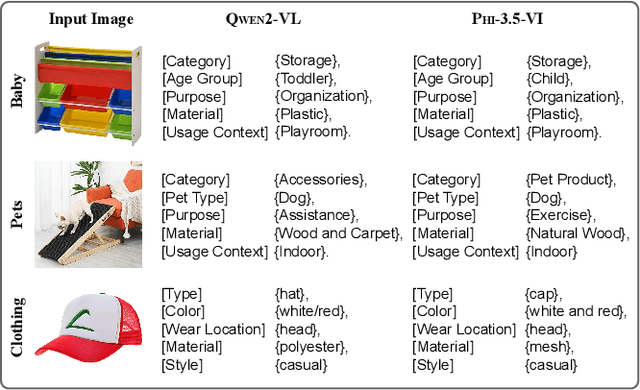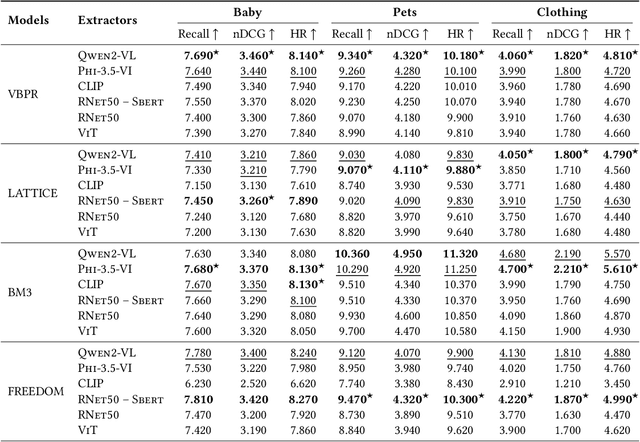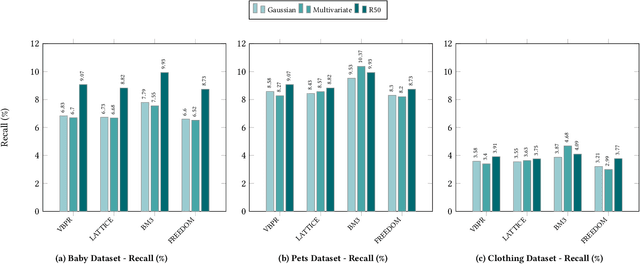Tommaso Di Noia
A Reproducible and Fair Evaluation of Partition-aware Collaborative Filtering
Dec 18, 2025Abstract:Similarity-based collaborative filtering (CF) models have long demonstrated strong offline performance and conceptual simplicity. However, their scalability is limited by the quadratic cost of maintaining dense item-item similarity matrices. Partitioning-based paradigms have recently emerged as an effective strategy for balancing effectiveness and efficiency, enabling models to learn local similarities within coherent subgraphs while maintaining a limited global context. In this work, we focus on the Fine-tuning Partition-aware Similarity Refinement (FPSR) framework, a prominent representative of this family, as well as its extension, FPSR+. Reproducible evaluation of partition-aware collaborative filtering remains challenging, as prior FPSR/FPSR+ reports often rely on splits of unclear provenance and omit some similarity-based baselines, thereby complicating fair comparison. We present a transparent, fully reproducible benchmark of FPSR and FPSR+. Based on our results, the family of FPSR models does not consistently perform at the highest level. Overall, it remains competitive, validates its design choices, and shows significant advantages in long-tail scenarios. This highlights the accuracy-coverage trade-offs resulting from partitioning, global components, and hub design. Our investigation clarifies when partition-aware similarity modeling is most beneficial and offers actionable guidance for scalable recommender system design under reproducible protocols.
On the Impact of Graph Neural Networks in Recommender Systems: A Topological Perspective
Dec 08, 2025Abstract:In recommender systems, user-item interactions can be modeled as a bipartite graph, where user and item nodes are connected by undirected edges. This graph-based view has motivated the rapid adoption of graph neural networks (GNNs), which often outperform collaborative filtering (CF) methods such as latent factor models, deep neural networks, and generative strategies. Yet, despite their empirical success, the reasons why GNNs offer systematic advantages over other CF approaches remain only partially understood. This monograph advances a topology-centered perspective on GNN-based recommendation. We argue that a comprehensive understanding of these models' performance should consider the structural properties of user-item graphs and their interaction with GNN architectural design. To support this view, we introduce a formal taxonomy that distills common modeling patterns across eleven representative GNN-based recommendation approaches and consolidates them into a unified conceptual pipeline. We further formalize thirteen classical and topological characteristics of recommendation datasets and reinterpret them through the lens of graph machine learning. Using these definitions, we analyze the considered GNN-based recommender architectures to assess how and to what extent they encode such properties. Building on this analysis, we derive an explanatory framework that links measurable dataset characteristics to model behavior and performance. Taken together, this monograph re-frames GNN-based recommendation through its topological underpinnings and outlines open theoretical, data-centric, and evaluation challenges for the next generation of topology-aware recommender systems.
Balancing Accuracy and Novelty with Sub-Item Popularity
Aug 07, 2025Abstract:In the realm of music recommendation, sequential recommenders have shown promise in capturing the dynamic nature of music consumption. A key characteristic of this domain is repetitive listening, where users frequently replay familiar tracks. To capture these repetition patterns, recent research has introduced Personalised Popularity Scores (PPS), which quantify user-specific preferences based on historical frequency. While PPS enhances relevance in recommendation, it often reinforces already-known content, limiting the system's ability to surface novel or serendipitous items - key elements for fostering long-term user engagement and satisfaction. To address this limitation, we build upon RecJPQ, a Transformer-based framework initially developed to improve scalability in large-item catalogues through sub-item decomposition. We repurpose RecJPQ's sub-item architecture to model personalised popularity at a finer granularity. This allows us to capture shared repetition patterns across sub-embeddings - latent structures not accessible through item-level popularity alone. We propose a novel integration of sub-ID-level personalised popularity within the RecJPQ framework, enabling explicit control over the trade-off between accuracy and personalised novelty. Our sub-ID-level PPS method (sPPS) consistently outperforms item-level PPS by achieving significantly higher personalised novelty without compromising recommendation accuracy. Code and experiments are publicly available at https://github.com/sisinflab/Sub-id-Popularity.
ViLLA-MMBench: A Unified Benchmark Suite for LLM-Augmented Multimodal Movie Recommendation
Aug 06, 2025Abstract:Recommending long-form video content demands joint modeling of visual, audio, and textual modalities, yet most benchmarks address only raw features or narrow fusion. We present ViLLA-MMBench, a reproducible, extensible benchmark for LLM-augmented multimodal movie recommendation. Built on MovieLens and MMTF-14K, it aligns dense item embeddings from three modalities: audio (block-level, i-vector), visual (CNN, AVF), and text. Missing or sparse metadata is automatically enriched using state-of-the-art LLMs (e.g., OpenAI Ada), generating high-quality synopses for thousands of movies. All text (raw or augmented) is embedded with configurable encoders (Ada, LLaMA-2, Sentence-T5), producing multiple ready-to-use sets. The pipeline supports interchangeable early-, mid-, and late-fusion (concatenation, PCA, CCA, rank-aggregation) and multiple backbones (MF, VAECF, VBPR, AMR, VMF) for ablation. Experiments are fully declarative via a single YAML file. Evaluation spans accuracy (Recall, nDCG) and beyond-accuracy metrics: cold-start rate, coverage, novelty, diversity, fairness. Results show LLM-based augmentation and strong text embeddings boost cold-start and coverage, especially when fused with audio-visual features. Systematic benchmarking reveals universal versus backbone- or metric-specific combinations. Open-source code, embeddings, and configs enable reproducible, fair multimodal RS research and advance principled generative AI integration in large-scale recommendation. Code: https://recsys-lab.github.io/ViLLA-MMBench
Do Recommender Systems Really Leverage Multimodal Content? A Comprehensive Analysis on Multimodal Representations for Recommendation
Aug 06, 2025



Abstract:Multimodal Recommender Systems aim to improve recommendation accuracy by integrating heterogeneous content, such as images and textual metadata. While effective, it remains unclear whether their gains stem from true multimodal understanding or increased model complexity. This work investigates the role of multimodal item embeddings, emphasizing the semantic informativeness of the representations. Initial experiments reveal that embeddings from standard extractors (e.g., ResNet50, Sentence-Bert) enhance performance, but rely on modality-specific encoders and ad hoc fusion strategies that lack control over cross-modal alignment. To overcome these limitations, we leverage Large Vision-Language Models (LVLMs) to generate multimodal-by-design embeddings via structured prompts. This approach yields semantically aligned representations without requiring any fusion. Experiments across multiple settings show notable performance improvements. Furthermore, LVLMs embeddings offer a distinctive advantage: they can be decoded into structured textual descriptions, enabling direct assessment of their multimodal comprehension. When such descriptions are incorporated as side content into recommender systems, they improve recommendation performance, empirically validating the semantic depth and alignment encoded within LVLMs outputs. Our study highlights the importance of semantically rich representations and positions LVLMs as a compelling foundation for building robust and meaningful multimodal representations in recommendation tasks.
LLaMAs Have Feelings Too: Unveiling Sentiment and Emotion Representations in LLaMA Models Through Probing
May 22, 2025Abstract:Large Language Models (LLMs) have rapidly become central to NLP, demonstrating their ability to adapt to various tasks through prompting techniques, including sentiment analysis. However, we still have a limited understanding of how these models capture sentiment-related information. This study probes the hidden layers of Llama models to pinpoint where sentiment features are most represented and to assess how this affects sentiment analysis. Using probe classifiers, we analyze sentiment encoding across layers and scales, identifying the layers and pooling methods that best capture sentiment signals. Our results show that sentiment information is most concentrated in mid-layers for binary polarity tasks, with detection accuracy increasing up to 14% over prompting techniques. Additionally, we find that in decoder-only models, the last token is not consistently the most informative for sentiment encoding. Finally, this approach enables sentiment tasks to be performed with memory requirements reduced by an average of 57%. These insights contribute to a broader understanding of sentiment in LLMs, suggesting layer-specific probing as an effective approach for sentiment tasks beyond prompting, with potential to enhance model utility and reduce memory requirements.
Are the Hidden States Hiding Something? Testing the Limits of Factuality-Encoding Capabilities in LLMs
May 22, 2025Abstract:Factual hallucinations are a major challenge for Large Language Models (LLMs). They undermine reliability and user trust by generating inaccurate or fabricated content. Recent studies suggest that when generating false statements, the internal states of LLMs encode information about truthfulness. However, these studies often rely on synthetic datasets that lack realism, which limits generalization when evaluating the factual accuracy of text generated by the model itself. In this paper, we challenge the findings of previous work by investigating truthfulness encoding capabilities, leading to the generation of a more realistic and challenging dataset. Specifically, we extend previous work by introducing: (1) a strategy for sampling plausible true-false factoid sentences from tabular data and (2) a procedure for generating realistic, LLM-dependent true-false datasets from Question Answering collections. Our analysis of two open-source LLMs reveals that while the findings from previous studies are partially validated, generalization to LLM-generated datasets remains challenging. This study lays the groundwork for future research on factuality in LLMs and offers practical guidelines for more effective evaluation.
Do LLMs Memorize Recommendation Datasets? A Preliminary Study on MovieLens-1M
May 15, 2025Abstract:Large Language Models (LLMs) have become increasingly central to recommendation scenarios due to their remarkable natural language understanding and generation capabilities. Although significant research has explored the use of LLMs for various recommendation tasks, little effort has been dedicated to verifying whether they have memorized public recommendation dataset as part of their training data. This is undesirable because memorization reduces the generalizability of research findings, as benchmarking on memorized datasets does not guarantee generalization to unseen datasets. Furthermore, memorization can amplify biases, for example, some popular items may be recommended more frequently than others. In this work, we investigate whether LLMs have memorized public recommendation datasets. Specifically, we examine two model families (GPT and Llama) across multiple sizes, focusing on one of the most widely used dataset in recommender systems: MovieLens-1M. First, we define dataset memorization as the extent to which item attributes, user profiles, and user-item interactions can be retrieved by prompting the LLMs. Second, we analyze the impact of memorization on recommendation performance. Lastly, we examine whether memorization varies across model families and model sizes. Our results reveal that all models exhibit some degree of memorization of MovieLens-1M, and that recommendation performance is related to the extent of memorization. We have made all the code publicly available at: https://github.com/sisinflab/LLM-MemoryInspector
Stealthy LLM-Driven Data Poisoning Attacks Against Embedding-Based Retrieval-Augmented Recommender Systems
May 08, 2025Abstract:We present a systematic study of provider-side data poisoning in retrieval-augmented recommender systems (RAG-based). By modifying only a small fraction of tokens within item descriptions -- for instance, adding emotional keywords or borrowing phrases from semantically related items -- an attacker can significantly promote or demote targeted items. We formalize these attacks under token-edit and semantic-similarity constraints, and we examine their effectiveness in both promotion (long-tail items) and demotion (short-head items) scenarios. Our experiments on MovieLens, using two large language model (LLM) retrieval modules, show that even subtle attacks shift final rankings and item exposures while eluding naive detection. The results underscore the vulnerability of RAG-based pipelines to small-scale metadata rewrites and emphasize the need for robust textual consistency checks and provenance tracking to thwart stealthy provider-side poisoning.
Training-Free Consistency Pipeline for Fashion Repose
Jan 23, 2025



Abstract:Recent advancements in diffusion models have significantly broadened the possibilities for editing images of real-world objects. However, performing non-rigid transformations, such as changing the pose of objects or image-based conditioning, remains challenging. Maintaining object identity during these edits is difficult, and current methods often fall short of the precision needed for industrial applications, where consistency is critical. Additionally, fine-tuning diffusion models requires custom training data, which is not always accessible in real-world scenarios. This work introduces FashionRepose, a training-free pipeline for non-rigid pose editing specifically designed for the fashion industry. The approach integrates off-the-shelf models to adjust poses of long-sleeve garments, maintaining identity and branding attributes. FashionRepose uses a zero-shot approach to perform these edits in near real-time, eliminating the need for specialized training. consistent image editing. The solution holds potential for applications in the fashion industry and other fields demanding identity preservation in image editing.
 Add to Chrome
Add to Chrome Add to Firefox
Add to Firefox Add to Edge
Add to Edge